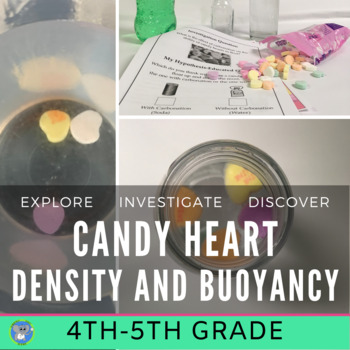Valentine Candy Heart Science And STEM | A Density And Buoyancy Lab Grade 4 5
- PDF
What educators are saying
Also included in
- Valentine-themed science to create excitement about sinking and floating. Get the complete grade-level series for a bundle discount. Explores density, buoyancy, and how life jackets work. Aligned to NGSS. Jam-packed with an investigation, station ideas, exploration challenge, and STEM challenge usinPrice $10.40Original Price $13.00Save $2.60
Description
Complete a hands-on unit introducing the Archimedes Principle with dancing candy hearts. Includes investigation, exploration, reading passages, and a STEM challenge. Budget-friendly and fun.
Included in the Hands-On Science and STEM:
- Alignment to *NGSS: 5th Grade Structures and Properties of Matter, 3-5 Science and Engineering Practices
- Teacher Background Information.
- 6-Page Investigation Journal
- Rubric and Answer Keys
- Reading Passage: How are dancing candy hearts like life jackets?
- Further Exploration Challenge
- STEM Exploration Challenge
- Life Jacket Anchor Chart
Students will follow the scientific method in a Valentine-themed lab to learn about sinking and floating. Students will explore the buoyant force of other materials. Students will follow the engineering design process to create a liquid that will increase the candy hearts dancing. They will discover how gas bubbles are candy hearts' life jackets.
Teachers will like it takes the classic dancing raisin experiment up a notch. A complete teacher's guide with tips is included. It is a memorable experience for all.
Uses simple and easily available supplies: Tall glasses, oil, Necc Sweethearts, diet soda, regular soda, stopwatch, paper towels, and other materials you choose for the STEM Challenge
Please note this experiment works best with the classic Necco Sweethearts which are now sold by SpanglerCandy (also called Sweethearts Candies the Original) or Brach's Tiny Conversation Hearts. However, we can not guarantee how the hearts will work. Make sure you test the experiment first and have raisins as a backup plan. Companies do change their recipe, and different brands of soda pop may act differently. This experiment is so much fun, but we want to make sure you have the correct supplies. Always remember this is science, and things may not always go as planned. We will provide you with lots of tips to improve success.
This investigation is part of a series. This is the 4th/5th-grade version. Please click each grade level version below to see more details.
Candy Heart Experiment: A Floating And Sinking Lab for K-1
Valentine Candy Heart Science: A Density And Buoyancy Lab For Grades 2 And 3
Valentine Candy Heart Science: K-5th Grade Bundle On Sinking And Floating
Great for the classroom, science fairs, STEM Fairs, science clubs, scout groups, centers, homeschoolers, and anyone wanting to explore the properties of matter.
If you like this, you may also like
Density, Buoyancy, And Soda Science Exploration 4th/5th Grade: The Floating Egg
Rainbow Milk: Experiment with Fat-in-Water Emulsions with 4th-5th Grade
Science Fair Project Labels And Editable Title Template
Remember leaving feedback earns you points toward FREE TPT purchases. We love hearing how the investigation went.
Also, follow us and be notified when new explorations are uploaded and deals.
Please contact us with any questions. We are here to help.
Yours in Science,
Kimberly Scott
All parts are copyrighted. Please see the terms of use in the download. Please use good lab practices. The seller is not responsible for the use or misuse of the activities.






